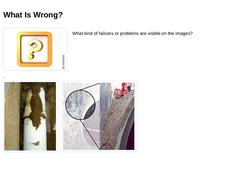
|
What kind of failures or problems are visible on the images? (Image: Inadequate working space at the side of the pipe (no arrow)) (Image: Inadequate working space at the side of the pipe – Proper compaction is impossible) |
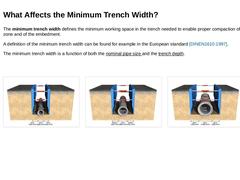
|
The minimum trench width defines the minimum working space in the trench needed to enable proper compaction of the haunch zone and of the embedment. A definition of the minimum trench width can be found for example in the European standard [DINEN1610:1997]. The minimum trench width is a function of both the nominal pipe size and the trench depth. (Image: Minimum trench width subject to the nominal pipe size) (Image: Minimum trench width subject to the … |
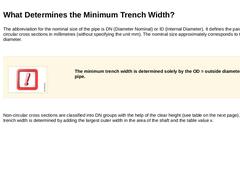
|
The abbreviation for the nominal size of the pipe is DN (Diameter Nominal) or ID (Internal Diameter). It defines the parameter for circular cross sections in millimetres (without specifying the unit mm). The nominal size approximately corresponds to the clear diameter. The minimum trench width is determined solely by the OD = outside diameter of the pipe. Non-circular cross sections are classified into DN groups with the help of … |
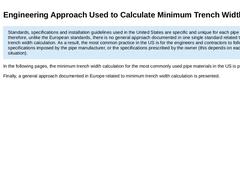
|
Standards, specifications and installation guidelines used in the United States are specific and unique for each pipe material, therefore, unlike the European standards, there is no general approach documented in one single standard related to minimum trench width calculation. As a result, the most common practice in the US is for the engineers and contractors to follow the specifications imposed by the pipe manufacturer, or the specifications prescribed … |
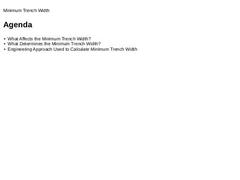
|
|
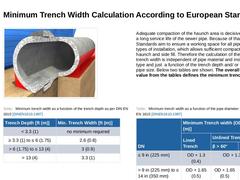
|
(Image: Pipe haunches for pipes with circular outer contour) Adequate compaction of the haunch area is decisive to achieve a long service life of the sewer pipe. Because of that, European Standards aim to ensure a working space for all pipes and types of installation, which allows sufficient compaction of the haunch and side fill. Therefore the calculation of the minimum trench width is independent of pipe material and installation type and just a … |
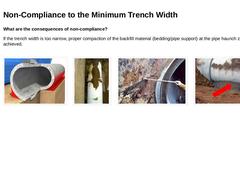
|
What are the consequences of non-compliance? If the trench width is too narrow, proper compaction of the backfill material (bedding/pipe support) at the pipe haunch zone cannot be achieved. (Image: Pipe haunches for pipes with circular outer contour) (Image: Inadequate working space at the side of the pipe (no arrow)) (Image: Non-compliance with the minimum trench width - Compaction of the haunch zone and side fill not possible) (Image: Non-compliance … |
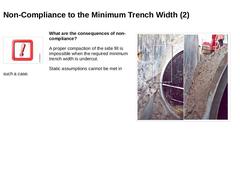
|
(Image: Attention!) What are the consequences of non-compliance? A proper compaction of the side fill is impossible when the required minimum trench width is undercut. Static assumptions cannot be met in such a case. (Image: Inadequate working space at the side of the pipe – Proper compaction is impossible) |
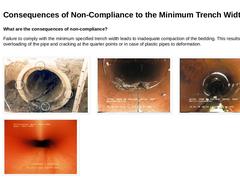
|
What are the consequences of non-compliance? Failure to comply with the minimum specified trench width leads to inadequate compaction of the bedding. This results in overloading of the pipe and cracking at the quarter points or in case of plastic pipes to deformation. (Image: Concrete pipe failure at the quarter points due to insufficient bedding compaction) (Image: Clay pipe failure due to insufficient bedding compaction) (Image: Clay pipe failure … |
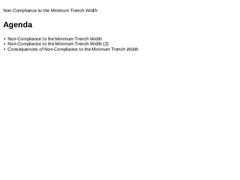
|
|
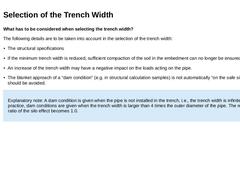
|
What has to be considered when selecting the trench width? The following details are to be taken into account in the selection of the trench width: -
The structural specifications
-
If the minimum trench width is reduced, sufficient compaction of the soil in the embedment can no longer be ensured.
-
An increase of the trench width may have a negative impact on the loads acting on the pipe.
-
The blanket approach of a “dam condition” (e.g. in structural …
|
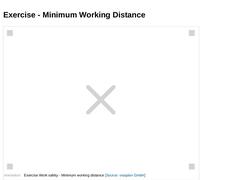
|
Animation: Exercise Work safety - Minimum working distance [Animation: visaplan GmbH]. This interactive object is only visible in the online version of the module. |

|
|
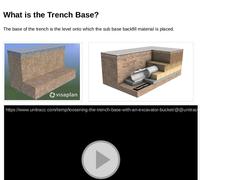
|
The base of the trench is the level onto which the sub base backfill material is placed. (Image: Trench base) (Image: Trench base) (Video: Loosening the trench base with an excavator bucket) Which excavator bucket is suitable for the trench base? Select the correct image by clicking on it. (Image: False excavator bucket) (Image: Correct excavator bucket) |
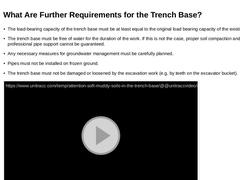
|
-
The load-bearing capacity of the trench base must be at least equal to the original load bearing capacity of the existing soil.
-
The trench base must be free of water for the duration of the work. If this is not the case, proper soil compaction and a professional pipe support cannot be guaranteed.
-
Any necessary measures for groundwater management must be carefully planned.
-
Pipes must not be installed on frozen ground.
-
The trench base must not …
|
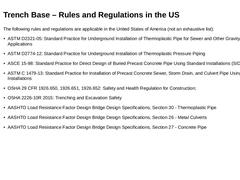
|
The following rules and regulations are applicable in the United States of America (not an exhaustive list): -
ASTM D2321-05: Standard Practice for Underground Installation of Thermoplastic Pipe for Sewer and Other Gravity-Flow Applications
-
ASTM D2774-12: Standard Practice for Underground Installation of Thermoplastic Pressure Piping
-
ASCE 15-98: Standard Practice for Direct Design of Buried Precast Concrete Pipe Using Standard Installations (SIDD)
|
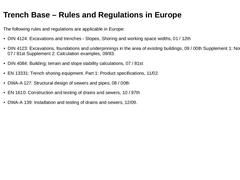
|
The following rules and regulations are applicable in Europe: -
DIN 4124: Excavations and trenches - Slopes, Shoring and working space widths, 01 / 12th
-
DIN 4123: Excavations, foundations and underpinnings in the area of existing buildings, 09 / 00th Supplement 1: Notes, 07 / 81st Supplement 2: Calculation examples, 09/83.
-
DIN 4084: Building; terrain and slope stability calculations, 07 / 81st
-
EN 13331: Trench shoring equipment. Part 1: Product …
|

|
|
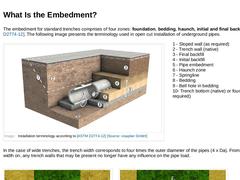
|
The embedment for standard trenches comprises of four zones: foundation, bedding, haunch, initial and final backfill [[ASTM D2774-12]]. The following image presents the terminology used in open cut installation of underground pipes. (Image: Installation terminology according to ASTM D 2774-12) 1 - Sloped wall (as required) 2 - Trench wall (native) 3 - Final backfill 4 - Initial backfill 5 - Pipe embedment 6 - Haunch zone 7 - Springline 8 - Bedding 9 - Bell … |
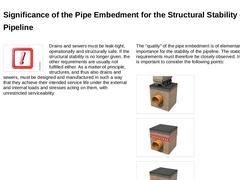
|
Important: Drains and sewers must be leak-tight, operationally and structurally safe. If the structural stability is no longer given, the other requirements are usually not fulfilled either. As a matter of principle, structures, and thus also drains and sewers, must be designed and manufactured in such a way that they achieve their intended service life under the external and internal loads and stresses acting on them, with unrestricted serviceability. |
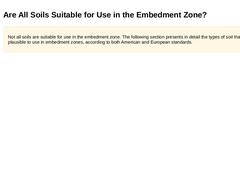
|
Not all soils are suitable for use in the embedment zone. The following section presents in detail the types of soil that are plausible to use in embedment zones, according to both American and European standards. |
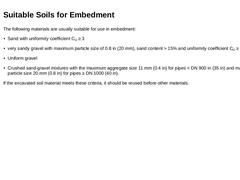
|
The following materials are usually suitable for use in embedment: -
Sand with uniformity coefficient CU ≥ 3
-
very sandy gravel with maximum particle size of 0.8 in (20 mm), sand content > 15% and uniformity coefficient CU ≥ 3
-
Uniform gravel
-
Crushed sand-gravel mixtures with the maximum aggregate size 11 mm (0.4 in) for pipes < DN 900 in (35 in) and maximum particle size 20 mm (0.8 in) for pipes ≥ DN 1000 (40 in).
If the excavated soil material meets … |
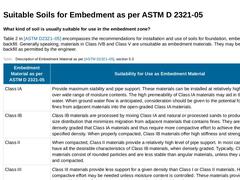
|
What kind of soil is usually suitable for use in the embedment zone? Table 2 in [[ASTM D2321–05]] encompasses the recommendations for installation and use of soils for foundation, embedment and backfill. Generally speaking, materials in Class IVB and Class V are unsuitable as embedment materials. They may be used as final backfill as permitted by the engineer. (Table: Description of embedment material [ASTM D 2321-05]) |
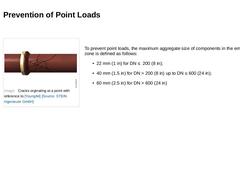
|
(Image: Cracks orginating at a point with reference to [Young84] [Image: S&P GmbH]) To prevent point loads, the maximum aggregate size of components in the embedment zone is defined as follows: -
22 mm (1 in) for DN ≤ 200 (8 in);
-
40 mm (1.5 in) for DN > 200 (8 in) up to DN ≤ 600 (24 in);
-
60 mm (2.5 in) for DN > 600 (24 in)
|
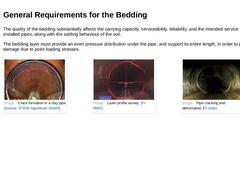
|
The quality of the bedding substantially affects the carrying capacity, serviceability, reliability, and the intended service life of the installed pipes, along with the settling behaviour of the soil. The bedding layer must provide an even pressure distribution under the pipe, and support its entire length, in order to prevent damage due to point loading stresses. (Image: Crack formation in a clay pipe) (Image: Laser profile survey) |